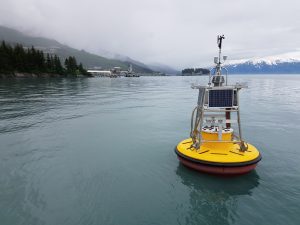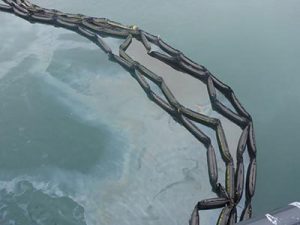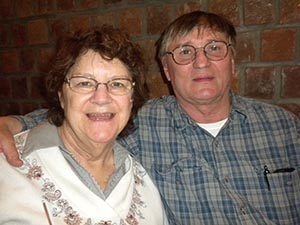Two new buoys are now in place and broadcasting weather conditions in the vicinity of the Valdez Marine Terminal.

The buoys collect weather data such as temperature, wind speed, wind direction, and barometric pressure, as well as oceanographic information like surface current direction and speed, wave heights, and water temperature. This data will help improve understanding of the meteorological and physical oceanographic environment in Port Valdez.
Weather conditions throughout Prince William Sound
Terminal buoy result of cooperative partnership
The buoy closest to the terminal (pictured above) is the result of a partnership between the Council, the Prince William Sound Science Center, Alyeska Pipeline Service Company, the City of Valdez, and Valdez Fisheries Development Association.
“Partnerships like these result in collaborative science, which is the best base for providing answers to challenging questions related to planning an effective oil spill response,” said Donna Schantz, Executive Director for the Council. “The Council has long advocated for this kind of data collection at the terminal and believe the information generated will contribute to best practices for prevention and response.”
The partnership is a result of an agreement reached between the Council, the City of Valdez, Prince William Sound Aquaculture Corporation, Valdez Fisheries Development Association, Alyeska Pipeline Service Company, and the Alaska Department of Environmental Conservation regarding protections in the Valdez Marine Terminal contingency plan for two nearby areas that are particularly sensitive to spilled oil, the Solomon Gulch fish hatchery and a salt marsh known as the Valdez Duck Flats.
In 1994, the tanker Eastern Lion spilled 8,400 gallons of North Slope crude oil into Port Valdez. Oil reached the Duck Flats and hatchery before protective boom was in place.
After that spill, changes were made to the Valdez Marine Terminal contingency plan to ensure that protections were deployed quickly. A rapid-decision tool, called a “matrix,” was created to help responders assess when to deploy protective boom to the Solomon Gulch Hatchery and Valdez Duck Flats during the critical early hours of a response. In 2017, the matrix was modified, and the Council, the City of Valdez, Valdez Fisheries Development Association, and Prince William Sound Aquaculture Corporation appealed that decision.
Earlier this year, the parties agreed to stay the appeal in lieu of a collaborative workgroup process. The workgroup’s goal is to reach consensus on how to ensure the protection of the Solomon Gulch Hatchery and Valdez Duck Flats. The buoys will provide scientific data to help the workgroup better understand how spilled oil will move in Port Valdez. This knowledge will help determine the timing for deploying protective boom.
Second buoy monitors Valdez Duck Flats
A second buoy has been deployed near the Valdez Duck Flats to monitor conditions in that location. The second buoy has been made possible by partnerships with Prince William Sound Science Center, the City of Valdez, and Valdez Fisheries Development Association.
Map
The map shows the locations of the two sensitive areas of concern, as well as the location of the new buoys. The hatchery is a little over two miles from the terminal, and the flats are approximately four miles.

